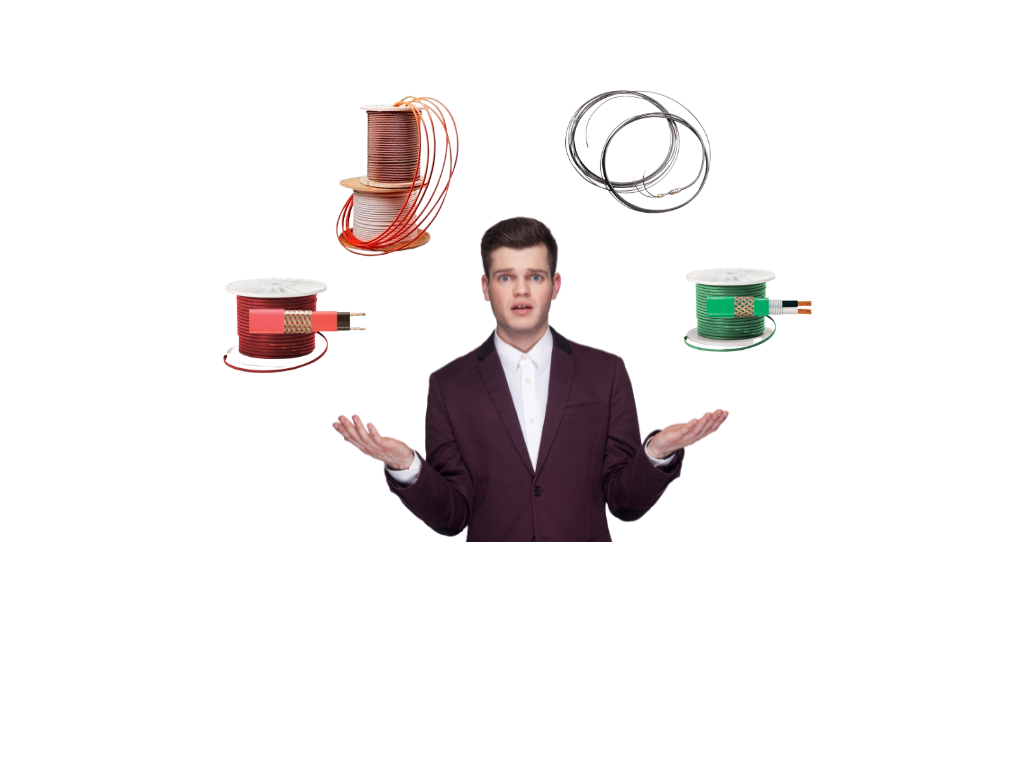Choosing the best heating cable
Choosing the best heating cable for your application depends on several factors, including the specific requirements of your application, the operating environment, and cost considerations. Here you will find a detailed comparison to help you make an informed decision:

Self-Regulating Heating Cables
Best For:
- Applications where temperature control and safety are paramount.
- Situations where energy efficiency is critical due to fluctuating ambient temperatures.
- Environments that require easy installation and on-site modifications.
Advantages:
- Adapts the power output to the ambient temperature and thus prevents overheating.
- Energy efficient, as it only uses the power required.
- Safe for use in hazardous areas.
- Easy to install and can be cut to the required length on site.
Disadvantages:
- Limited maximum temperature (typically up to 150°C).
- Generally higher cost compared to constant wattage cables.
- Not suitable for very high temperature applications.
Power-Limiting Heating Cables
Best For:
- Applications that require precise temperature control.
- High temperature environments where consistent performance is required.
- Situations where energy efficiency is important but more control is needed than with self-regulating cables.
Advantages:
- Maintains a constant temperature over the entire length of the cable.
- Suitable for high-temperature applications (up to 260°C).
- Energy efficient and offers better control than self-regulating cables.
Disadvantages:
- More complex to design and install.
- Higher cost compared to self-regulating cables and constant wattage cables.
- Less flexible for on-site changes.
Parallel Constant Watt Heating Cables
Best For:
- Applications that require uniform heating over long distances.
- Situations where flexibility in installation (cutting to length) is important.
- Cost-sensitive applications where precise temperature control is less important.
Advantages:
- Provides a uniform wattage per unit length.
- Flexible and can be cut to the required length on site.
- Cost effective compared to other types of heating cable.
Disadvantages:
- Danger of overheating due to improper installation.
- Less energy efficient as it consumes constant power regardless of the ambient temperature.
- Limited temperature range (typically up to 200°C).
Mineral Insulated (MI) Heating Cables
Best For:
- Extreme environments that require high durability and temperature resistance.
- Applications requiring very high power output and precise control.
- Long-term installations where durability and reliability are critical.
Advantages:
- Can work at very high temperatures (up to 600°C).
- Extremely durable and resistant to mechanical damage, chemicals, and moisture.
- Ensures constant and precise temperature maintenance.
- Long service life.
Disadvantages:
- Higher costs compared to other types of heating cables.
- Less flexible, which makes installation more difficult.
- Requires special knowledge and equipment for installation.
- Cannot be easily cut or modified on site.
Decision Criteria
1. Temperature Requirements:
- MI heating cables are the best choice for applications that require very high temperatures.
- For medium to high temperatures, power-limiting heating cables are suitable.
- For lower temperature applications, self-regulating or parallel constant watt heating cables may be suitable.
2. Energy Efficiency:
- Self-regulating and power-limiting heating cables are more energy-efficient due to their ability to adjust power.
- Parallel constant wattage heating cables are less energy efficient.
3. Installation Flexibility:
- Self-regulating and parallel constant watt heating cables offer more flexibility for on-site modifications.
- MI heating cables are less flexible and require more precise installation.
4. Cost Considerations:
- Parallel constant watt heating cables are generally the most cost-effective.
- Self-regulating and power-limiting heating cables are more expensive but offer additional benefits in terms of safety and energy efficiency.
- MI heating cables are the most expensive, but offer the highest durability and temperature resistance.
Conclusion
For most applications:
- Self-regulating heating cables are best suited for low to medium temperature applications where energy efficiency and safety are priorities.
- Power-limiting heating cables are suitable for high-temperature applications that require precise temperature control.
- Parallel constant watt heating cables are cost-effective for applications that require uniform heating over long distances without critical temperature control.
- Mineral insulated (MI) heating cables are ideal for extreme environments requiring high temperatures, durability, and longevity.
